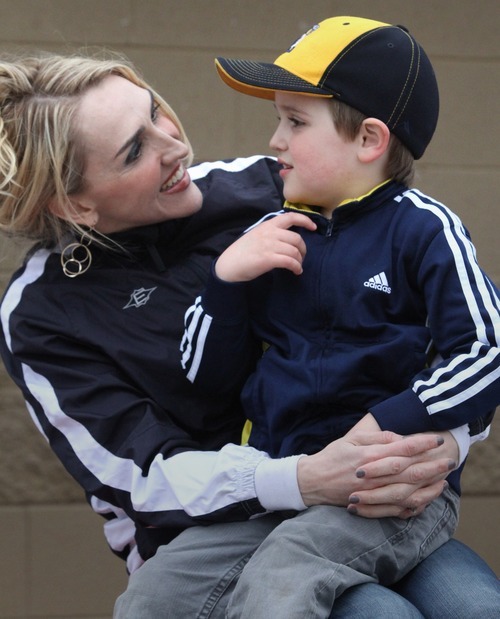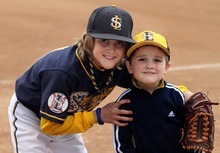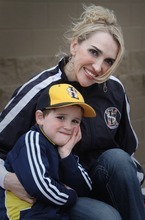This is an archived article that was published on sltrib.com in 2012, and information in the article may be outdated. It is provided only for personal research purposes and may not be reprinted.
One out of 47 Utah children have been identified as having an autism spectrum disorder, the highest rate in the country, according to new data released Thursday by the Centers for Disease Control and Prevention.
The 2008 data from 14 communities found a national rate of one in 88 children with autism. It also showed autism is five times more likely in boys than in girls, with one in 54 boys identified nationally.
In Utah, boys are almost three times as likely to have autism than girls with one in 32 boys identified, according to the new data, versus one in 85 girls.
Yet there has been a nearly 1,200 percent increase in identified girls in Utah between 2002 and 2008, said Judith Zimmerman, a researcher at the University of Utah's Department of Psychiatry.
Hispanic and black children had the largest increases in autism identification nationally, according to the new data.
Researchers say the spike is real in Utah and can't be attributed to over diagnosis or a different definition of autism. However, the new Utah rate comes solely from a sample pool of about 2,000 children — the smallest group in the nation — in a single urban area along the Wasatch Front.
"Is it accurate for all of Utah?" Zimmerman said. "I don't know."
A previous study of 25,000 Utah children in 2008 found the diagnosis rate to be 1 in 77. For the new rate, researchers examined a subset of about 2,000 children and found that one in 47 met the criteria for autism.
The impact of Utah's autistic children will be felt in Utah's schools, said Larry Shumway, the state superintendent of public instruction.
"They'll be found in every classroom," he said, noting that upcoming teachers need to have the skills to meet the wave.
Children with autism often have difficulty with communication and social skills, and may have sensory sensitivity.
"I'm scared by the numbers," said Peter Nicholas, director of the Carmen B. Pingree Center, which provides services to children with autism. It typically has a waiting list of 150 to 240 children for its preschool, he said, explaining that some parents of children with autism place their babies on the list — even if they don't know yet if the younger sibling has a diagnosis.
The national increase — a 78 percent boost from 2002 to 2008 — can be partly attributed to how children are being identified and served, researchers acknowledged, although how much that is affecting the surge is unclear.
Cathy Fegan-Kim the mother of a 12-year-old boy at Pingree, said the new data was significant but added, "I want more focus on research and what's causing it so this number doesn't keep rising."
Researchers at Wednesday's press conference at Pingree said the causes of autism are unknown, but are thought to be a blend of genetic factors and possible environmental triggers. They did not speculate on any possible reasons for Utah's high rate. New Jersey ranks second to Utah in autism frequency with a rate of 1 in 49.
They are now studying records from 25,000 Utah children who were ages 4 and 8 in 2010.
Draper father Robert Jeppsen isn't shocked to hear the latest autism numbers. His son has been battling what the family at first saw as an autism death sentence for their son Crew, now 4.
Diagnosed around 2, he wouldn't make eye contact, made lots of repetitive motions and did not speak at all.
But years of specialists later, Crew will enroll in a mainstream school next fall. The father hopes other parents don't make the mistake of waiting to get help for their child.
"I want him to be happy, I want him to do things with his life rather than have people put him in a box and say, 'Can't, can't, can't," he said.
Advocates at the press conference called on insurance companies to cover treatments for autism, which can deplete a family of its savings as thousands are spent annually on specialists.
For three years, the Jeppsens have spent more than $50,000 annually for Crew including speech therapy, socialization therapy, specialized schools and dietary restrictions — none of which was covered by insurance.
"It changed our lives, it changed what we plan for our retirement future," Jeppsen said. "That kind of cash just isn't lying around."
But the sacrifice was worth it, Jeppsen said. Crew has a "gigantic" and "hilarious" personality, his dad says, something they discovered once they cut through the fog of autism.
Although his son still has challenges, ranging from eye contact to socializing, "He's a different boy," Jeppsen said.
Utah begins autism services
O The state will begin paying for autism therapy for several hundred children later this year. Find more information online. > 1.usa.gov/HlVUJR —
About the research
The new analysis suggests that the frequency of autism identified nationally increased 23 percent between 2006 to 2008, and 78 percent between 2002 to 2008. An increasing number of children are identified earlier — before age 3 — but the majority are not diagnosed until 4 or older.
The study focuses on 14 areas in the U.S., allowing researchers to study different regions and groups simultaneously. Other sites in the study are in Colorado, Florida, Missouri, Arizona, Arkansas, Alabama, Georgia, North Carolina, South Carolina, Pennsylvania, Maryland, New Jersey and Wisconsin.









